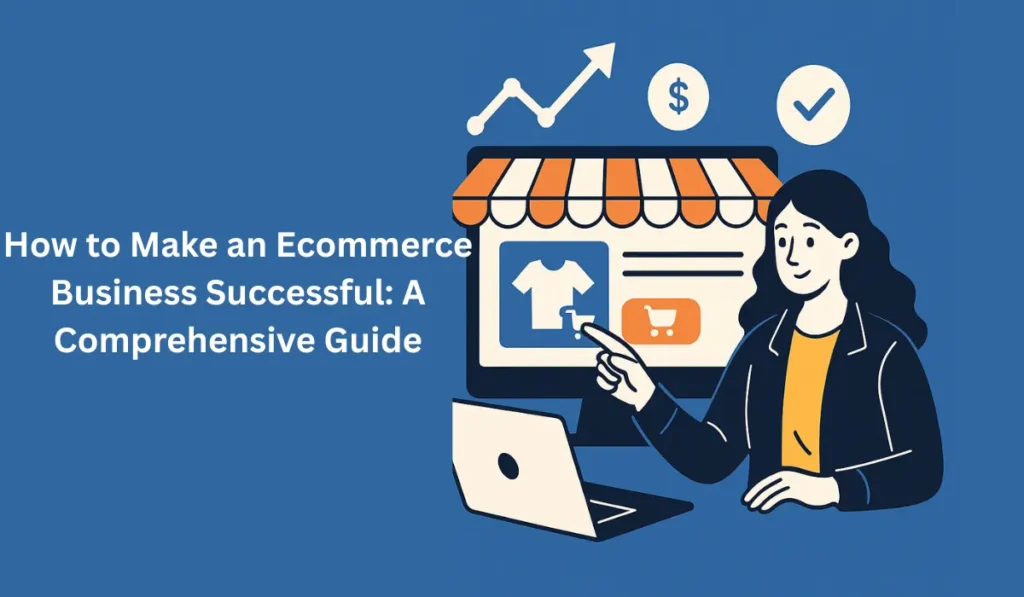The ecommerce industry is booming, with global sales expected to reach $8.5 trillion by 2026. However, competition is fierce, and many online businesses struggle to survive. To build a successful ecommerce business, you need a solid strategy, excellent execution, and continuous optimization.
In this guide, we’ll cover the key steps to launching and scaling a successful ecommerce business.
Choose the Right Ecommerce Business Model
Choosing the right eCommerce business model is crucial for success, as it determines how you source, sell, and deliver products or services to customers. Here’s a breakdown of the most common eCommerce business models to help you select the best one for your venture:
1. Business-to-Consumer (B2C)
- Definition: Selling products directly to individual consumers.
- Examples: Amazon, Nike, Walmart.
- Best For: Brands targeting end-users with everyday products.
- Pros: Large customer base, faster sales cycles.
- Cons: High competition, price sensitivity.
2. Business-to-Business (B2B)
- Definition: Selling products/services to other businesses.
- Examples: Alibaba, Shopify (for merchants), wholesale suppliers.
- Best For: Manufacturers, bulk suppliers, SaaS companies.
- Pros: Larger order values, recurring contracts.
- Cons: Longer sales cycles, relationship-dependent.
3. Consumer-to-Consumer (C2C)
- Definition: Consumers sell directly to other consumers via a platform.
- Examples: eBay, Facebook Marketplace, Poshmark.
- Best For: Individuals reselling used or handmade goods.
- Pros: Low startup costs, flexible.
- Cons: Limited control over inventory, trust issues.
4. Consumer-to-Business (C2B)
- Definition: Individuals sell products/services to businesses.
- Examples: Freelancers (Upwork, Fiverr), stock photo contributors.
- Best For: Influencers, freelancers, content creators.
- Pros: High demand for niche skills, passive income potential.
- Cons: Requires strong personal branding.
5. Dropshipping
- Definition: Seller lists products but doesn’t hold inventory; supplier ships directly.
- Examples: Oberlo-based stores, Spocket.
- Best For: Entrepreneurs with low upfront capital.
- Pros: No inventory risk, low startup cost.
- Cons: Low margins, shipping dependency.
6. White Labeling & Private Labeling
- Definition: Selling generic products under your own brand.
- Examples: Private-label Amazon FBA sellers.
- Best For: Brand builders with marketing skills.
- Pros: Higher brand control, better margins.
- Cons: Requires investment in branding & inventory.
7. Subscription Model
- Definition: Customers pay recurring fees for regular product deliveries.
- Examples: Dollar Shave Club, Birchbox.
- Best For: Niche products with repeat demand.
- Pros: Predictable revenue, customer retention.
- Cons: High churn risk, logistics complexity.
8. Print-on-Demand (POD)
- Definition: Products are printed & shipped only after an order is placed.
- Examples: Printify, Redbubble.
- Best For: Artists, designers, low-risk sellers.
- Pros: No inventory, customizable.
- Cons: Lower margins, longer shipping times.
How to Choose the Right Model?
Budget: Dropshipping/POD requires less capital; inventory models need more.
Skills: B2B needs sales expertise; B2C requires marketing.
Scalability: Subscription & SaaS models scale well.
Market Demand: Research trends (e.g., eco-friendly products).
Test different models (e.g., start with dropshipping, then move to private labeling). The best model aligns with your goals, budget, and target audience.
Find a Profitable Niche
Choosing the right niche is one of the most critical steps in building a successful eCommerce business. A well-researched niche reduces competition, increases profitability, and helps you target the right audience.
A well-defined niche increases your chances of success. Consider:
1. Understand What Makes a Niche Profitable
A good niche should have:
Demand – People are actively searching for and buying products in this category.
Profitability – Products have healthy margins (at least 30-50%).
Low Competition – Not dominated by big brands or oversaturated markets.
Passionate Audience – Buyers are engaged and willing to spend (e.g., hobbyists, professionals).
2. Brainstorm Niche Ideas
Start by listing interests, problems, and trends. Consider:
- Hobbies & Interests (fitness, gardening, pet care)
- Problems & Pain Points (ergonomic office gear, sleep aids)
- Emerging Trends (eco-friendly products, AI gadgets)
- Evergreen Markets (health, beauty, home improvement)
Tools for Idea Generation:
- Google Trends – Check rising search trends.
- Amazon Best Sellers – See what’s popular.
- Reddit & Quora – Find discussions on niche problems.
- Facebook Groups & Forums – Identify passionate communities.
3. Validate Demand & Profitability
A. Check Search Volume & Interest
- Google Keyword Planner – High search volume = strong demand.
- AnswerThePublic – Find common questions in your niche.
- Trending Hashtags (Instagram/TikTok) – Viral products often indicate demand.
B. Analyze Competition
- Amazon & eBay – If top products have 100+ reviews, it’s competitive but proven.
- AliExpress & Dropshipping Stores – Check if many stores sell the same product.
- Google Search – Few optimized blogs or stores? = Opportunity!
C. Profitability Check
- Use Jungle Scout/Helium 10 (for Amazon) or SaleHoo (for wholesale) to estimate margins.
- Compare Supplier Costs (AliBaba, CJ Dropshipping) vs. Selling Price (Shopify, Amazon).
4. Narrow Down to a Sub-Niche (Micro-Niche)
Instead of selling “fitness equipment”, focus on:
- “Yoga mats for plus-size women”
- “Resistance bands for physical therapy”
- “Eco-friendly gym accessories”
Why? Less competition, easier SEO, and better-targeted marketing.
5. Test Before Fully Committing
- Run a Facebook/Google Ads test (even with a simple landing page).
- Start small with dropshipping to gauge interest before bulk ordering.
- Sell on eBay/Etsy first to validate demand.
Source High-Quality Products
Finding reliable suppliers and high-quality products is crucial for customer satisfaction, brand reputation, and long-term success.
Your product quality defines your brand reputation. Options include:
- Manufacturers (Alibaba, ThomasNet) – Best for bulk orders.
- Wholesale Suppliers (SaleHoo, Wholesale Central) – Lower per-unit costs.
- Dropshipping (Oberlo, Spocket, Zendrop) – No upfront inventory costs.
- Handmade/Custom Products (Etsy, Printful) – Unique, personalized items.
Pro Tip: Order samples to test quality before selling.
Build a Professional Ecommerce Website
A well-designed eCommerce website is crucial for converting visitors into customers. Here’s a complete guide to building a high-converting online store.
Your website is your storefront. Key elements:
A. Choose an Ecommerce Platform
- Shopify – Best for beginners (easy setup, great apps).
- WooCommerce – WordPress plugin (flexible but requires tech skills).
- BigCommerce – Scalable for high-growth stores.
- Wix/Squarespace – Simpler but less powerful for e-commerce.
B. Optimize for User Experience (UX)
- Mobile-Friendly Design (60%+ traffic comes from mobile).
- Fast Loading Speed (Use GTmetrix to test).
- Simple Navigation & Checkout (Reduce cart abandonment).
- High-Quality Images & Videos – Showcase products effectively.
C. Secure Payment Gateways
- Offer multiple options: Credit Cards, PayPal, Apple Pay, Google Pay, Buy Now Pay Later (BNPL).
- Ensure SSL encryption for security.
Develop a Strong Brand Identity
A powerful brand identity helps you stand out, build trust, and create loyal customers. Here’s a step-by-step guide to crafting a memorable and professional brand.
- Logo & Color Scheme – Consistent across all platforms.
- Brand Voice & Messaging – Align with your target audience.
- Packaging & Unboxing Experience – Enhances customer satisfaction.
Example: Glossier’s minimalist branding appeals to millennials.
Also Read
Drive Traffic to Your Store
To generate sales, you need consistent, high-quality traffic to your store. Below are the most effective strategies to attract visitors—both free and paid.
A. Search Engine Optimization (SEO)
- Optimize product pages with keywords, meta descriptions, and alt text.
- Publish blog content to attract organic traffic (e.g., “Best Running Shoes for Flat Feet”).
- Get backlinks from reputable sites.
B. Paid Advertising
- Facebook & Instagram Ads – Highly targeted based on interests.
- Google Shopping Ads – Great for product searches.
- Influencer Marketing – Partner with micro-influencers for credibility.
C. Social Media Marketing
- TikTok & Instagram Reels – Viral product showcases.
- Pinterest – Ideal for visually appealing products.
- Email Marketing – Build a list and send promotions (Klaviyo, Mailchimp).
D. Content Marketing
- YouTube product reviews.
- Podcast sponsorships.
- User-generated content (encourage customers to share photos).
Convert Visitors into Customers
Traffic means nothing without conversions. Turning website visitors into buyers is the lifeblood of your eCommerce business. Here’s your ultimate guide to maximizing conversions:
- Clear CTAs (Buy Now, Add to Cart).
- Customer Reviews & Testimonials (Trustpilot, Yotpo).
- Limited-Time Discounts & Scarcity Tactics (“Only 3 left!”).
- Live Chat Support (Zendesk, Tidio).
Retain Customers & Encourage Repeat Sales
Turning one-time buyers into loyal, repeat customers is 5-7x cheaper than acquiring new ones. Here’s your complete playbook for building customer loyalty and maximizing lifetime value (LTV):
- Loyalty Programs (Points, discounts for repeat buyers).
- Email Drip Campaigns (Abandoned cart emails, post-purchase follow-ups).
- Upselling & Cross-Selling (“Customers also bought…”).
- Exceptional Customer Service – Fast responses, easy returns.
Analyze & Optimize Performance
Turning raw data into profit-boosting decisions separates thriving stores from struggling ones. Here’s your complete guide to eCommerce analytics and optimization:
- Conversion Rate (Aim for 2-3%+).
- Average Order Value (AOV) – Increase with bundles.
- Customer Lifetime Value (CLV) – Measure repeat purchase rate.
- Traffic Sources – Double down on what works.
Tools: Google Analytics, Hotjar, Shopify Reports.
Scale Your Ecommerce Business
Scaling an eCommerce business requires moving beyond basic operations to systematic growth.
Once profitable, expand with:
- New Product Lines – Based on customer demand.
- International Shipping – Use fulfillment centers (ShipBob, Amazon FBA).
- Wholesale & B2B Sales – Sell to retailers.
- Automation – Use AI chatbots, inventory management tools.
Final Thoughts
Building a successful ecommerce business takes time, effort, and smart strategies. Focus on:
Choosing the right niche & products
Creating a seamless shopping experience
Driving targeted traffic
Converting & retaining customers
Continuously optimizing & scaling
By following this roadmap, you’ll be well on your way to ecommerce success.



